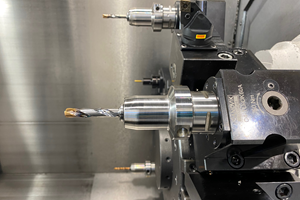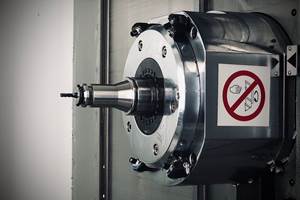New Okuma Plant Relies on Automation, Production Control
The company says the DS1 facility in Japan is capable of 2 times the production capacity and 1/2 the lead time of the previous site.
Share






With its newest manufacturing facility in Oguchi, Japan, machine tool builder Okuma literally has made a clean break from its previous approaches to production. The manufacturing facility that previously stood on the site of this plant was leveled in 2012. On May 20, 2013, the company completed construction of the replacement plant, DS1, a 254,000-square-foot facility for the production of CNC lathes and multitasking machines. The first of an expected series of so-called “Dream Site” facilities, the DS1 plant is capable of 2 times the production and 1/2 the lead time of the facility it replaced. Staffing, meanwhile, is roughly the same.
The company says that increasing manufacturing capacity in Japan was necessary to its aim of increasing sales volume outside of Japan. While serving various machining needs in various industries and international markets has led to an expanded product line, competing effectively in those markets requires the company to achieve not just competitive pricing but also competitive delivery. The result is a challenge that many of Okuma’s customers would immediately recognize: the need to manufacture responsively and cost-effectively in an environment of high product variety and low production volumes. The now-operational DS1 facility is the company’s answer to this challenge.
The facility was open to the public in November as part of the company’s Okuma Machine Fair 2013 open house, and I had the chance at this event to talk about the facility with company president and CEO Yoshimaro (Dean) Hanaki. For Okuma, overcoming the high-mix/low-volume challenge entailed all of these elements:
â—ŹAutomation. The principal way the plant expanded capacity was not by adding space or people, but by taking advantage of time that formerly went unused. In the past, says Mr. Hanaki, production would stop during the night and on weekends. In the new plant, automation is used extensively to enable machines to keep producing when staffing is slight.
That automation consists of robot loading of machine tools in some cases. However, the most visible and extensive type of automation in the shop is the flexible manufacturing system. Various lines in the facility consist of multiple Okuma machining centers united by a Fastems pallet loading system, which in turn draws work from a multi-story rack of pallets accommodating the setups for numerous part numbers. By swapping pallets in and out of the machines as frequently as needed, this configuration enables the machining centers to keep running efficiently even though batch sizes are small and the variety of machined parts is large.
The approach even makes sense when the parts themselves are large. The biggest of DS1’s FMS cells is 120 meters long. The Fastems system in this case unites four Okuma double-column machining centers that each has 2.5 meters between columns. This FMS for large parts machines 80 of the plant’s biggest part numbers.
â—ŹConsolidation. Following an approach that is practically the opposite of outsourcing, the DS1 plant seeks cost efficiency by combining nearly all of the steps in machine tool production under one roof. Raw material input, machining, kitting, subassembly, final assembly, inspection and shipping all occur within the facility.
A philosophy of consolidation drives the plant’s approach to assembly as well. Machines do not move from station to station as they are being built. Instead, for greater simplicity, each machine remains in one place on the assembly floor, with components and subassemblies all carted to the machines as they are needed.
â—ŹProduction control. While the company was building this new plant, it was also building the information system essential to making it work. A production control system coordinates orders and manufacturing capacity in order to schedule part numbers productively on the FMS lines, and also to ensure that parts are delivered just as they are needed to machines being assembled.
Mr. Hanaki says the development of this system, though less visible than other resources in the plant, represents a significant share of the engineering that went into making this facility a success. Without a comprehensive system able to rationalize numerous orders into an as-needed component production and delivery schedule, the only alternative would be to maintain large inventories to ensure that needed components are available. The danger, he says, is that the production facility can come to resemble a warehouse.
â—ŹEnergy savings. One other significant source of production expense is energy. The DS1 plant saves this cost by combining energy-conserving features such as LED lighting with renewable power generation through solar panels on the roof and one of the building’s walls. Compared to plant it replaced, this plant’s energy consumption is 30 percent less.
Related Content
Shop Reclaims 10,000 Square Feet with Inventory Management System
Intech Athens’ inventory management system, which includes vertical lift modules from Kardex Remstar and tool management software from ZOLLER, has saved the company time, space and money.
Read MoreForm Tapping Improves Tool Life, Costs
Moving from cut tapping to form tapping for a notable application cut tooling costs at Siemens Energy and increased tool life a hundredfold.
Read MoreBriquetting Manufacturer Tools Up for Faster Turnaround Times
To cut out laborious manual processes like hand-grinding, this briquette manufacturer revamped its machining and cutting tool arsenal for faster production.
Read MoreHow to Troubleshoot Issues With Tool Life
Diagnosing when a tool is failing is important because it sets an expectation and a benchmark for improvements. Finding out why gives us a clue for how to fix it.
Read MoreRead Next
Last Chance! 2025 Top Shops Benchmarking Survey Still Open Through April 30
Don’t miss out! 91ĘÓƵÍřŐľÎŰ's Top Shops Benchmarking Survey is still open — but not for long. This is your last chance to a receive free, customized benchmarking report that includes actionable feedback across several shopfloor and business metrics.
Read MoreMachine Shop MBA
Making Chips and 91ĘÓƵÍřŐľÎŰ are teaming up for a new podcast series called Machine Shop MBA—designed to help manufacturers measure their success against the industry’s best. Through the lens of the Top Shops benchmarking program, the series explores the KPIs that set high-performing shops apart, from machine utilization and first-pass yield to employee engagement and revenue per employee.
Read MoreAMRs Are Moving Into Manufacturing: Considerations for Implementation
AMRs can provide a flexible, easy-to-use automation platform so long as manufacturers choose a suitable task and prepare their facilities.
Read More





















